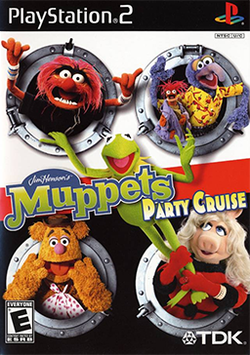Gameplay
Muppets Party Cruise has six playable characters: Kermit, Piggy, Fozzie, Gonzo, Animal and Pepe, and six non-playable characters: Statler and Waldorf, Rowlf, Rizzo, Swedish Chef, Sam the Eagle, Bunsen and Beaker. The game contains 30 mini-games, 15 of which the player must unlock, [2] and five levels: the Engine Room, Crew's Quarters, Quality Cabins, Star Suites and Royal Staterooms. Players may also choose between a long and short cruise.
The currency is party favors that are accrued by unlocking additional party games from the menu, but during gameplay, players use cruise credits. [3] [4]
In "long cruise" mode, players may freely roam a tiled cruise ship. They roll a die at the start of each round and may advance that number of spaces. Around the walls of the cruise ship are doors; entering the blue, red or green doors starts multiplayer mini-games, and entering the yellow doors rewards the player with lottery-style one-player games in which the player may win more cruise credits. When a player wins a mini-game accessed via a red, blue or green door, the player receives a party favor of that color. When a player accumulates enough party favors, the game is over and the total party favors collected by all players are added to the saved balance, which can unlock mini-games. [5]
In "short cruise" mode, the first player may select a mini-game in which everyone will compete, but no party favors are won.
This page is based on this
Wikipedia article Text is available under the
CC BY-SA 4.0 license; additional terms may apply.
Images, videos and audio are available under their respective licenses.
